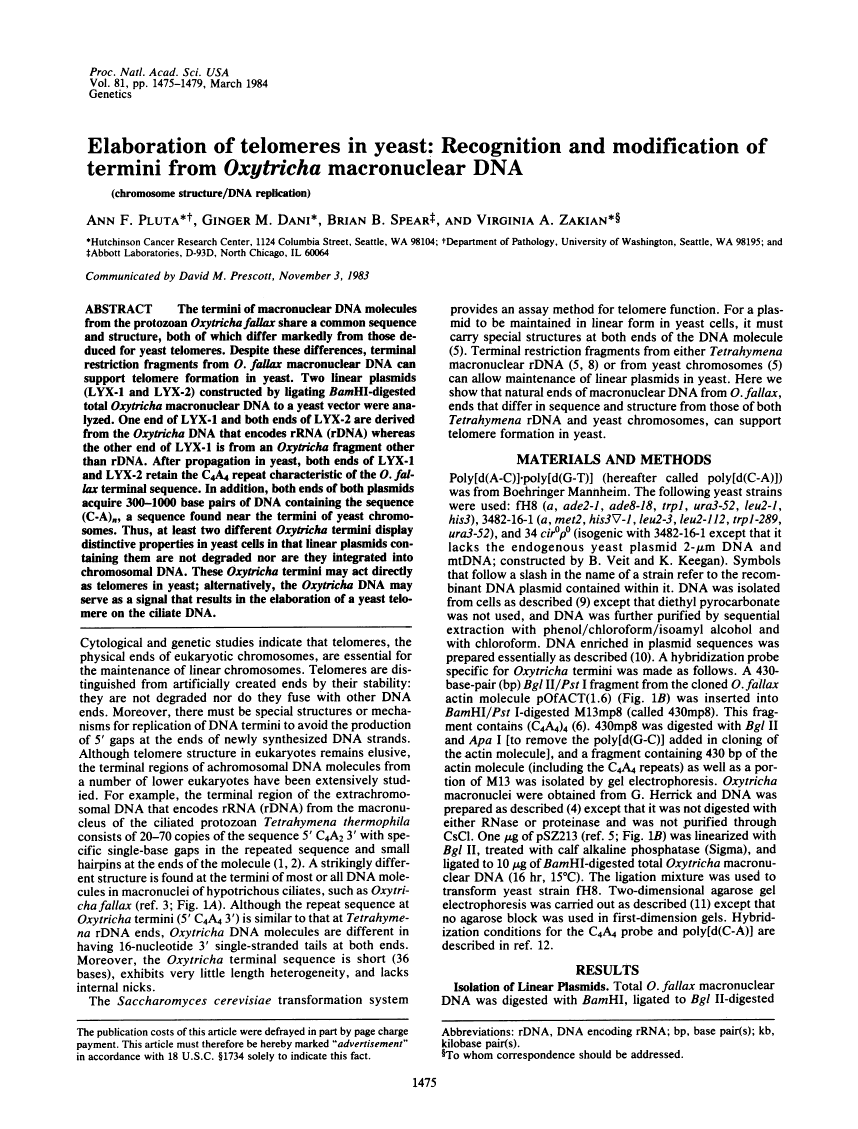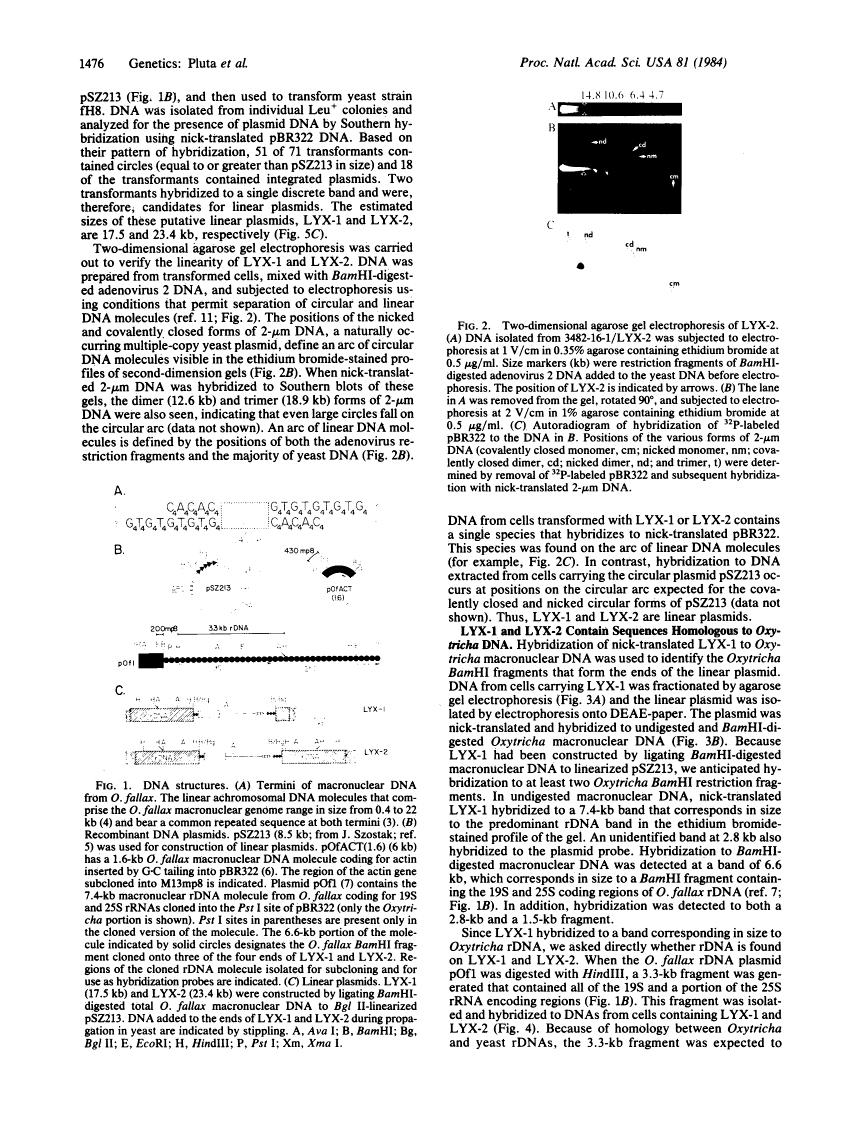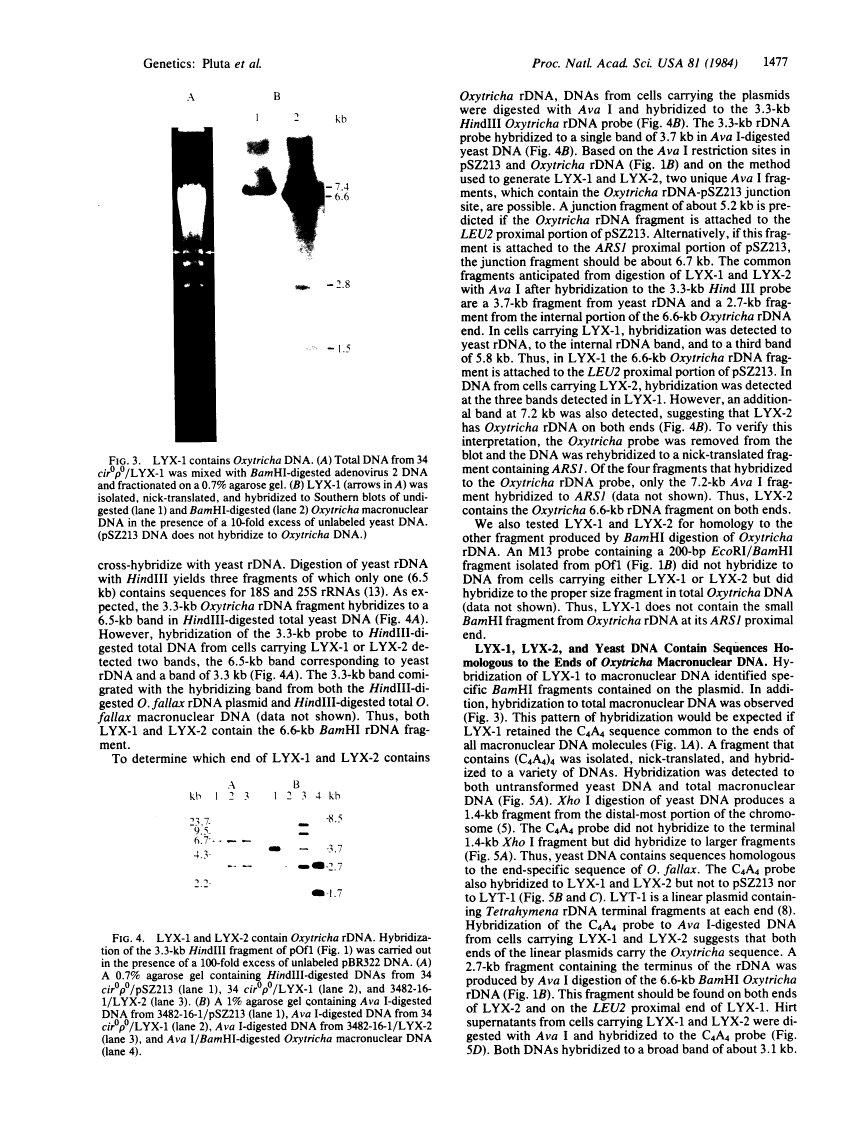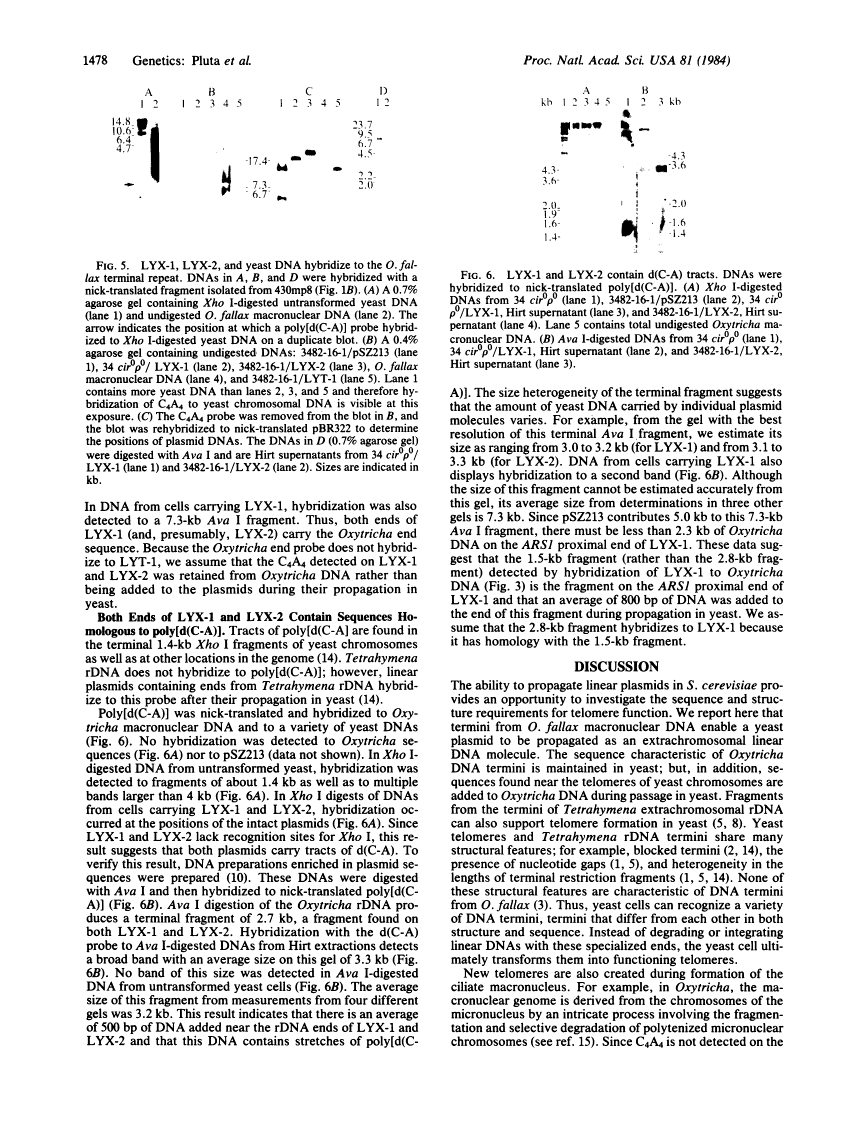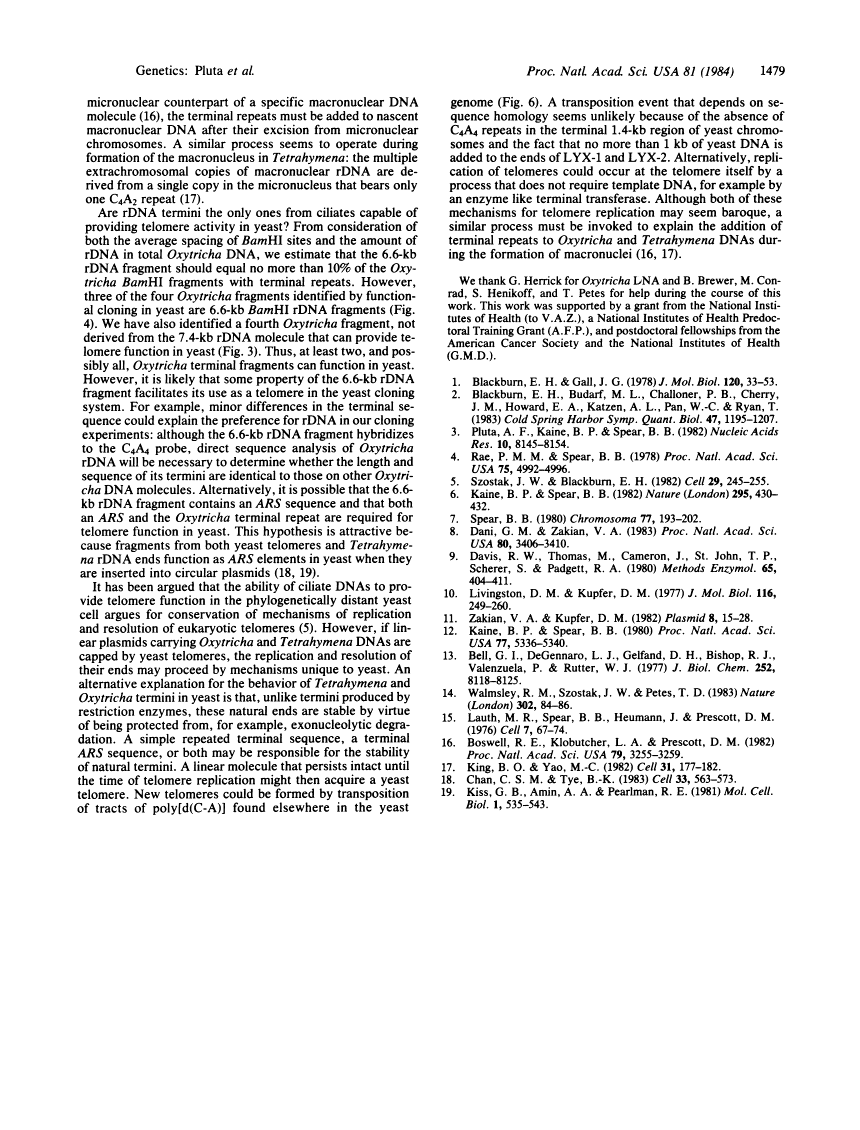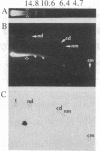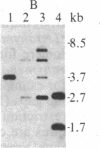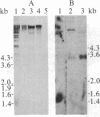Abstract
Free full text

Elaboration of telomeres in yeast: recognition and modification of termini from Oxytricha macronuclear DNA.
Abstract
The termini of macronuclear DNA molecules from the protozoan Oxytricha fallax share a common sequence and structure, both of which differ markedly from those deduced for yeast telomeres. Despite these differences, terminal restriction fragments from O. fallax macronuclear DNA can support telomere formation in yeasts. Two linear plasmids (LYX-1 and LYX-2) constructed by ligating BamHI-digested total Oxytricha macronuclear DNA to a yeast vector were analyzed. One end of LYX-1 and both ends of LYX-2 are derived from the Oxytricha DNA that encodes rRNA (rDNA) whereas the other end of LYX-1 is from an Oxytricha fragment other than rDNA. After propagation in yeast, both ends of LYX-1 and LYX-2 retain the C4A4 repeat characteristic of the O. fallax terminal sequence. In addition, both ends of both plasmids acquire 300-1000 base pairs of DNA containing the sequence (C-A)n, a sequence found near the termini of yeast chromosomes. Thus, at least two different Oxytricha termini display distinctive properties in yeast cells in that linear plasmids containing them are not degraded nor are they integrated into chromosomal DNA. These Oxytricha termini may act directly as telomeres in yeast; alternatively, the Oxytricha DNA may serve as a signal that results in the elaboration of a yeast telomere on the ciliate DNA.
Full text
Full text is available as a scanned copy of the original print version. Get a printable copy (PDF file) of the complete article (1.3M), or click on a page image below to browse page by page. Links to PubMed are also available for Selected References.
Images in this article
Click on the image to see a larger version.
Selected References
These references are in PubMed. This may not be the complete list of references from this article.
- Blackburn EH, Gall JG. A tandemly repeated sequence at the termini of the extrachromosomal ribosomal RNA genes in Tetrahymena. J Mol Biol. 1978 Mar 25;120(1):33–53. [Abstract] [Google Scholar]
- Blackburn EH, Budarf ML, Challoner PB, Cherry JM, Howard EA, Katzen AL, Pan WC, Ryan T. DNA termini in ciliate macronuclei. Cold Spring Harb Symp Quant Biol. 1983;47(Pt 2):1195–1207. [Abstract] [Google Scholar]
- Pluta AF, Kaine BP, Spear BB. The terminal organization of macronuclear DNA in Oxytricha fallax. Nucleic Acids Res. 1982 Dec 20;10(24):8145–8154. [Europe PMC free article] [Abstract] [Google Scholar]
- Rae PM, Spear BB. Macronuclear DNA of the hypotrichous ciliate Oxytricha fallax. Proc Natl Acad Sci U S A. 1978 Oct;75(10):4992–4996. [Europe PMC free article] [Abstract] [Google Scholar]
- Szostak JW, Blackburn EH. Cloning yeast telomeres on linear plasmid vectors. Cell. 1982 May;29(1):245–255. [Abstract] [Google Scholar]
- Kaine BP, Spear BB. Nucleotide sequence of a macronuclear gene for actin in Oxytricha fallax. Nature. 1982 Feb 4;295(5848):430–432. [Abstract] [Google Scholar]
- Spear BB. Isolation and mapping of the rRNA genes in the macronucleus of Oxytricha fallax. Chromosoma. 1980;77(2):193–202. [Abstract] [Google Scholar]
- Dani GM, Zakian VA. Mitotic and meiotic stability of linear plasmids in yeast. Proc Natl Acad Sci U S A. 1983 Jun;80(11):3406–3410. [Europe PMC free article] [Abstract] [Google Scholar]
- Davis RW, Thomas M, Cameron J, St John TP, Scherer S, Padgett RA. Rapid DNA isolations for enzymatic and hybridization analysis. Methods Enzymol. 1980;65(1):404–411. [Abstract] [Google Scholar]
- Livingston DM, Kupfer DM. Control of Saccharomyces cerevisiae 2microN DNA replication by cell division cycle genes that control nuclear DNA replication. J Mol Biol. 1977 Oct 25;116(2):249–260. [Abstract] [Google Scholar]
- Zakian VA, Kupfer DM. Replication and segregation of an unstable plasmid in yeast. Plasmid. 1982 Jul;8(1):15–28. [Abstract] [Google Scholar]
- Kaine BP, Spear BB. Putative actin genes in the macronucleus of Oxytricha fallax. Proc Natl Acad Sci U S A. 1980 Sep;77(9):5336–5340. [Europe PMC free article] [Abstract] [Google Scholar]
- Bell GI, DeGennaro LJ, Gelfand DH, Bishop RJ, Valenzuela P, Rutter WJ. Ribosomal RNA genes of Saccharomyces cerevisiae. I. Physical map of the repeating unit and location of the regions coding for 5 S, 5.8 S, 18 S, and 25 S ribosomal RNAs. J Biol Chem. 1977 Nov 25;252(22):8118–8125. [Abstract] [Google Scholar]
- Walmsley RM, Szostak JW, Petes TD. Is there left-handed DNA at the ends of yeast chromosomes? Nature. 1983 Mar 3;302(5903):84–86. [Abstract] [Google Scholar]
- Lauth MR, Spear BB, Heumann J, Prescott DM. DNA of ciliated protozoa: DNA sequence diminution during macronuclear development of Oxytricha. Cell. 1976 Jan;7(1):67–74. [Abstract] [Google Scholar]
- Boswell RE, Klobutcher LA, Prescott DM. Inverted terminal repeats are added to genes during macronuclear development in Oxytricha nova. Proc Natl Acad Sci U S A. 1982 May;79(10):3255–3259. [Europe PMC free article] [Abstract] [Google Scholar]
- King BO, Yao MC. Tandemly repeated hexanucleotide at Tetrahymena rDNA free end is generated from a single copy during development. Cell. 1982 Nov;31(1):177–182. [Abstract] [Google Scholar]
- Chan CS, Tye BK. Organization of DNA sequences and replication origins at yeast telomeres. Cell. 1983 Jun;33(2):563–573. [Abstract] [Google Scholar]
- Kiss GB, Amin AA, Pearlman RE. Two separate regions of the extrachromosomal ribosomal deoxyribonucleic acid of Tetrahymena thermophila enable autonomous replication of plasmids in Saccharomyces cerevisiae. Mol Cell Biol. 1981 Jun;1(6):535–543. [Europe PMC free article] [Abstract] [Google Scholar]
Associated Data
Articles from Proceedings of the National Academy of Sciences of the United States of America are provided here courtesy of National Academy of Sciences
Full text links
Read article at publisher's site: https://doi.org/10.1073/pnas.81.5.1475
Read article for free, from open access legal sources, via Unpaywall:
https://europepmc.org/articles/pmc344859?pdf=render
Citations & impact
Impact metrics
Citations of article over time
Smart citations by scite.ai
Explore citation contexts and check if this article has been
supported or disputed.
https://scite.ai/reports/10.1073/pnas.81.5.1475
Article citations
How do the ends replicate?
Trends Biochem Sci, 35(1):5-7, 11 Dec 2009
Cited by: 0 articles | PMID: 20005723
The ends have arrived.
Cell, 139(6):1038-1040, 01 Dec 2009
Cited by: 9 articles | PMID: 20005795 | PMCID: PMC2963196
Humanized telomeres and an attempt to express a functional human telomerase in yeast.
Nucleic Acids Res, 32(6):1917-1927, 26 Mar 2004
Cited by: 19 articles | PMID: 15047858 | PMCID: PMC390362
Beginning to understand the end of the chromosome.
Cell, 116(2):273-279, 01 Jan 2004
Cited by: 275 articles | PMID: 14744437
Review
Biochemical aspects of telomerase function.
Cancer Lett, 194(2):139-154, 01 May 2003
Cited by: 57 articles | PMID: 12757972
Review
Go to all (54) article citations
Other citations
Similar Articles
To arrive at the top five similar articles we use a word-weighted algorithm to compare words from the Title and Abstract of each citation.
Formation and stability of linear plasmids in a recombination deficient strain of yeast.
Curr Genet, 9(6):441-445, 01 Jan 1985
Cited by: 2 articles | PMID: 3916729
Three different macronuclear DNAs in Oxytricha fallax share a common sequence block.
Mol Cell Biol, 4(5):931-938, 01 May 1984
Cited by: 27 articles | PMID: 6328276 | PMCID: PMC368842
Cloning yeast telomeres on linear plasmid vectors.
Cell, 29(1):245-255, 01 May 1982
Cited by: 346 articles | PMID: 6286143
Yeast DNA plasmids.
Annu Rev Microbiol, 37:253-276, 01 Jan 1983
Cited by: 38 articles | PMID: 6357054
Review
